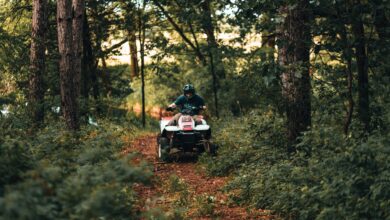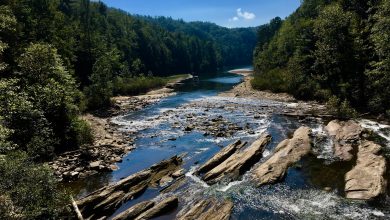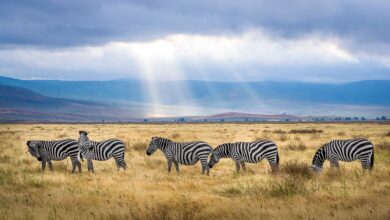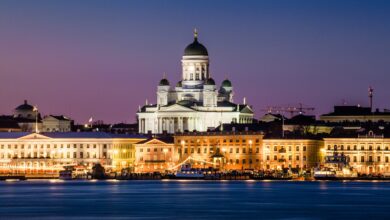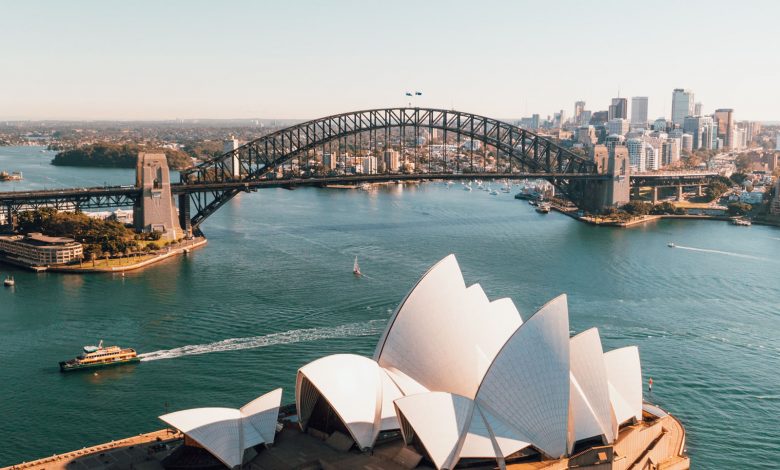
Heads up: some of the links on this site are affiliate links. If you click and make a booking or purchase, I’ll make a commission (at no extra cost to you). I partner with companies I personally use and the $$ goes towards creating more awesome, free travel content.
My first ever big solo trip was to Australia when I was 21. I visited Lagos Portugal for a vacation with my friend and while I was there I met lots of Aussies who told me I should pay a visit to the Land Down Under.
Since I’d just left university and wasn’t sure what to do with my life, I thought that didn’t seem like a bad idea, so I did some bartending and saved up enough money to spend 6 weeks backpacking Australia.
The flight was a little bit nerve-wracking. Had I made a big mistake traveling there by myself? Would I look like a loser with no friends? Would I be lonely?
As it turns out, I had the time of my life. I made life-long friends that I still meet up with today.
I started in Sydney, took the Oz experience bus up the east coast of Australia and then flew to Alice Springs to do a tour of Uluru. I then flew to Melbourne to meet up with a friend I’d met on the east coast and we drove the Great Ocean Road.
I didn’t realize it so much at the time but that trip really shaped me as a person. It taught me to get out of my comfort zone and I learned how to strike up conversations with strangers. I did all sorts of exciting activities I’d never done before, such as skydiving, driving a 4×4 on the beach and swimming in the Great Barrier Reef.
Australia is the perfect place to visit if you’re planning your first solo trip. It’s relatively safe, people speak English so there’s less of a language barrier and the country has some really epic scenery and things to do. From beaches to deserts to tropical rainforests, Australia has an incredibly diverse landscape that’s perfect for outdoor adventures.
This guide to backpacking Australia covers everything you need to know about visiting the country, including how to get around, where to stay and how to plan the most awesome itinerary.
How to Get Cheap Flights to Australia
One of the largest costs you’ll face is buying flights to Australia. Since the country is so far away from everywhere else, flights can cost in the thousands.
If you’re coming from Europe you’ll usually have a stopover somewhere like Doha, Dubai, Bangkok, Singapore or Kuala Lumpur. Flight times vary but you can expect the journey to take around 23-24 hours.
If you’re flying from the US, Qantas, Delta and United offer direct flights from Los Angeles to Sydney that take around 15 hours.
The 5 busiest airports in Australia are:
- Sydney (SYD)
- Melbourne (MEL)
- Brisbane (BNE)
- Perth (PER)
- Adelaide (ADL)
Most people choose to fly in and out of Sydney Airport because it receives the most flights and prices are usually the cheapest. However, it’s worth checking to the other airports to see which destination has the cheapest flights.
If you’re flexible about when you go, then consider signing up for Jack’s Flight Club (UK) or Scott’s Cheap Flights (US). These are email subscription services where you’ll be sent flight deals straight to your inbox, including flash sales and mistake fares. Sometimes they send deals on flights to Australia, so you could easily jump on a good fare if you see it.
Besides flight clubs, these are my top tips for finding cheap flights to Australia:
Collect Air Miles
Sign up for an air miles credit card and make sure you hit the minimum spend so you can get the sign up bonus. Most credit cards offer between 50,000 and 100,000 bonus miles just for signing up.
Once you’ve hit the bonus, make sure you put all your daily spending on the card so you get as many air miles as possible. You may be able to accumulate enough miles for an economy ticket to Australia.
In the U.S some popular cards include the Chase Sapphire Preferred Credit Card, the American Express Gold Card and the Capital One Venture Rewards Credit Card.
Fly During Off-Season or Shoulder Season
The most popular time to visit Australia is during the Australian summer (December to February). Consider visiting during autumn (March to May), winter (June to August) or spring (September to November) to get the cheapest flights.
Use Flight Comparison Sites
These days I find Google Flights to be the best search engine for finding flights, but you can also cross reference the prices with sites like Kayak, Expedia and Skyscanner.
I also really love using the Hopper app because you can easily track prices and the app will tell you if it’s a good time to buy or not. If the app thinks prices may go down in the next few weeks then it might be best holding off your purchase until you see a better price.
Consider Booking With Separate Airlines
One time I had trouble finding cheap tickets to Australia so I booked a return ticket to Kuala Lumpur and then I purchased two separate single tickets from Kuala Lumpur to Melbourne and back with budget carrier Air Asia.
Best Hostels in Australia
There are lots of great hostels all over Australia, which you can book through Hostelworld. In peak season (ie Australian summer) hostels can get booked up so if you want rooms in the best hostels you’ll need to book in advance.
That being said, you’ll probably end up throwing your itinerary out the window. On my backpacking trip up the east coast of Australia I had a very loose itinerary with only a hop on hop off bus pass.
Sometimes I made friends in hostels and then ended up staying longer in a place than I initially anticipated. I therefore often made my hostel reservations for the next destination either the same day or the night before my arrival.
Here’s a list of some of the best hostels in Australia:
How to Get Around Australia
On my first visit to Australia I did the Oz Experience hop on hop off bus (which was quite the party) but this is sadly no longer operating. Instead you’ll need to choose one of the following options for getting around:
Domestic Flights
Since Australia is enormous, the fastest way to get between cities and towns is by flying, although this is often the most expensive option. Airlines that operate domestic flights in Australia include Qantas, Virgin Australia, Jetstar, and Rex Airlines.
Long Distance Bus
Buses are great (and cheap) if you don’t need to get anywhere fast. If you’re traveling up the East Coast between Sydney and Cairns I’d recommend traveling by bus and stopping off at all the major hotspots and towns along the way.
Bus journeys can be long but you’ll usually be sharing the experience with other backpackers and they’re great if you don’t want to worry about driving.
Greyhound Australia is the most obvious choice since its network covers the entire country. They offer a variety of Whimit Travel Passes, which allow unlimited travel on any route, in any direction, so you can visit as many places as you want. Here are the prices:
- 15-day Whimit Pass – $349
- 30-day Whimit Pass – $439
- 60-day Whimit Pass – $499
- 90-day Whimit Pass – $629
- 120-day Whimit Pass – $749
There are also smaller bus companies such as Premier, Murrays and Tassielink, which operate in certain regions of Australia.
Train
While you can travel by train, tickets can be expensive and it’s not the most popular way for backpackers to get around.
The country does have two very iconic routes though – The Indian-Pacific (IP) and The Ghan, which are privately operated by Journey Beyond Rail Expeditions. The Indian Pacific cuts across the country between the west and east linking Perth to Sydney, while The Ghan runs between the north and south linking Adelaide and Darwin.
If you can afford to do it and you want the experience of traveling across the country in an iconic train, then you may want to consider adding it to your itinerary.
There are also regional train systems in Queensland, New South Wales, Victoria and Perth.
Campervan or Car Hire
After buses the other most popular way to get around Australia is by hiring a car or a campervan.
Remember they drive on the left hand side of the road in Australia. This is easy for Brits, but if you’re from the US or Europe this will take some getting used to. Having your own vehicle is a lot of fun because it gives you the autonomy to go wherever you want, whenever you want.
However, it’s a lot of driving so I don’t recommend doing it on your own. If you’re traveling solo, go with the Greyhound option.
Jucy, Wicked Campers and Britz are three of the most popular local campervan operators in Australia. The great thing about hiring a campervan is that it also doubles as your accommodation so you can pull up to camp sites and you don’t always have to stay in hostels.
If you’re planning to stay in Australia for a year while you do your working holiday then you may want to consider buying a campervan or a vehicle if it makes sense.
If you just want to do the odd day trip from a city like Sydney or Melbourne then car rental works just fine. Check out comparison sites such as Kayak and Rentalcars.com to find the best deals.
Magic Bus
While the Oz Experience no longer operates in Oz, there is another backpacker bus on the block called Magic Bus, which is aimed at 18-35 year olds.
If you want to booze, party and meet other backpackers then you may want to give this a try. This 25 seater bus operates 3-4 week road trips that depart each month. Itineraries vary but you’re guaranteed festival style vibes and good times.
Best Places to Visit in Australia
States
Australia has a total of six states and two territories. These include:
- New South Wales
- Northern Territory
- Queensland
- South Australia
- Tasmania
- Victoria
- Western Australia
- Australian Capital Territory
If you want to see all the states and territories then you’ll need around 3 months to see them properly. If you don’t have as much time as that, then you’ll need to pick your destinations wisely. Each state has its own charms, so it really comes down to personal preference.
For a first-time trip to Australia I’d recommend doing the east coast Australia backpacker route, visiting New South Wales and Queensland. It’s a popular route, so you’ll meet a lot of people and have plenty of fun. You could also add on Melbourne and the Great Ocean Road if you have the time.
If you’d rather get away from the crowds and explore some beautiful scenery, then Western Australia is incredibly beautiful. It all depends on what you want to see and do!
Cities
Sydney – Sydney is the most visited city in Australia and is known for its iconic Opera House plus beaches such as Bondi Beach and Coogee Beach. There’s a lot to do in Sydney; highlights include climbing the Sydney Harbour Bridge, strolling through the Royal Botanical Gardens and wandering through The Rocks, which is Australia’s first European settlement.
Brisbane – Brisbane is the capital of Queensland and a lot of the action centers around the Brisbane River. My favorite thing to do here is wander around the South Bank where you’ll find a beautiful park with barbecues, restaurants and even a man made beach. While you’re in Brisbane you can climb the Story Bridge and visit Brisbane’s Islands, including Moreton Island, Bribie Island and North Stradbroke Island.
Cairns – Cairns is a major gateway for exploring the Great Barrier Reef and the Daintree Rainforest. The city has a tropical climate so if you’re visiting during summer you’ll definitely want to find a hostel with a pool so you can cool off! Things to do in Cairns include strolling along the Cairns Esplanade and relaxing by the saltwater Lagoon, which is lined with trees, boardwalks and barbecues.
Melbourne – Melbourne is my favorite city in Australia. It reminds me of some cities in Europe because of the tram system. Melbourne has a hipster vibe and is known for its coffee shops and brunches so it’s definitely a great spot to visit if you’re a foodie. You’ll definitely find a quality Flat White here! From Melbourne most backpackers rent a vehicle and drive the Great Ocean Road.
Perth – Western Australia’s capital Perth experiences more sunny days than any other Australian city so it’s the perfect place for al fresco dining and relaxing on the beach. The city has a laid back vibe but there are plenty of things to do such as exploring art galleries, walking in leafy King’s Park and visiting the vineyards in Swan Valley. While you’re there I’d recommend taking a boat to Rottnest Island to meet the adorable quokkas and experiencing a Sunday Session at Cottesloe Beach.
Best Things to Do in Australia
Blue Mountains – This rugged mountain region is located a 2 hour drive west of Sydney in New South Wales. The region is known for its beautiful mountain scenery, including sandstone ridges, rugged cliffs, green valleys and underground caves. The Blue Mountains boasts over 140 kilometres (87 miles) of hiking trails as well as the world’s steepest railway.
Byron Bay – Bryon Bay is a famous beach town on the east coast of Australia in New South Wales. It’s a popular spot for surfing, so if you’ve never surfed before, here’s your chance to take some beginner lessons! The town has a laid back, hippie vibe with lots of restaurants and backpacker bars – it’s a super fun place to party!
Noosa – Noosa is a sophisticated resort town on Queensland’s Sunshine Coast, known for its beautiful beaches and excellent surf. Most of the action is centered around Hastings Street, which is filled with boutiques and seafood restaurants. A popular activity here is kayaking through the Noosa Everglades, which are home to lots of species of birds including pelicans, ducks, cormorants and eagles.
4×4 on Fraser Island – One of the highlights of the east coast is a visit to Fraser Island. You can book a self-drive 4×4 adventure where you’ll be given maps, tide times and instructions for how to drive your 4×4 on the sand. You’ll drive on the beaches, try sandboarding down the island’s sand dunes and camp overnight under the stars!
Sailing the Whitsundays – Airlie Beach is a major base for sailing the Whitsundays, which is a chain of 74 islands off the Queensland Coast. These islands are home to secluded coves and pristine white beaches, including the famous Whitehaven Beach. If you book a Whitsundays Sailing tour you’ll spend a night or two on board a yacht, stopping at various beaches for snorkeling and other activities along the way.
Magnetic Island – One of my favorite stops in Queensland was Magnetic Island, which lies about 8km (5 miles) off the coast of Townsville. This lush, tropical island is home to palm-fringed beaches, hiking trails and plenty of wildlife including dingoes, echidnas, cassowaries and saltwater crocodiles. A highlight of visiting Magnetic Island is hiring a topless car rental and driving around the island with the wind in your hair.
Great Barrier Reef – Named one of the Seven Natural Wonders of the World, the Great Barrier Reef is the world’s largest coral reef system. There are many ways to view the ocean life here, including snorkeling, scuba diving, aircraft or helicopter tours, glass-bottomed boats, semi-submersibles and cruise ship tours.
Daintree Rainforest – Daintree Rainforest has been growing for more than 180 million years and is the world’s oldest tropical rainforest. It’s a must-see on your Queensland itinerary. As well as hiking the rainforest’s extensive trails, you can go rafting on the Mossman River, see the canopy from an aerial walkway and take a crocodile cruise to get an up-close view of the saltwater crocs.
Uluru – One of Australia’s most iconic landmarks, Uluru (Ayers Rock) is a huge sandstone rock formation in the middle of Australia near Alice Springs. Tours will take you to see the rock at both sunrise and sunset, plus you’ll also have the chance to see Kata Tjuta (The Olgas), which are a group of orange, domed rock formations located about 40km west of Uluru.
Great Ocean Road – This famous coastal road in the state of Victoria is one of the most scenic drives in the world. The road starts in Torquay and ends in Allansford, passing beautiful beaches, rugged coastline and friendly seaside towns along the way. A major highlight is the 12 Apostles, which consist of limestone pillars that have been formed over 10 to 20 million years.
Flinders Ranges – A lot of people skip South Australia but I’ve found it to be one of the most beautiful parts of the country. The Flinders Ranges is a stunning mountain range about 500 kilometers (311 miles) north of Adelaide. On a tour to the Flinders Ranges you’ll sleep underneath the stars in a ‘swag’ and visit the extraordinary Wilpena Pound, which looks like a giant crater but is actually a natural amphitheater made up of the stumps of mountains.
Barossa Wine Valley – This famous wine region in South Australia is home to lots of well-known wineries, including Jacob’s Creek, Penfolds and Wolf Blass. The Barossa is known for producing excellent reds, including Shiraz, Cabernet and Grenache.
Kangaroo Island – Located off Australia’s south coast, Kangaroo Island is home to all sorts of wildlife. Watch seals chilling on the shore at Seal Bay, see little penguins up close at Penneshaw Penguin Centre and learn all about bee conservation at Island Beehive.
Shark Cage Diving in Port Lincoln – If you’re traveling through South Australia and feeling brave then you can come face to face with Great White Sharks by booking a shark cage diving experience. You’ll travel by boat from Port Lincoln out to the Neptune Islands to look for Great Whites in their natural habitat.
Margaret River – Margaret River is a beautiful wine region in Western Australia that’s known for its wineries, vineyards, craft breweries and boutiques. The coastline here is spectacular too and is known for its epic surf breaks that attract surfers from all over the world. The region is home to award winning wineries so if you’re visiting Perth, I recommend making the trip out there to do some wine tasting.
Kakadu National Park – Kakadu is one of the oldest national parks in Australia, located in the Northern Territory. It is rich in Aboriginal cultural sites and is home to over 2,000 plant species as well as many bird and animal species. It’s an excellent place for wildlife watching and you’ll have the chance to see animals such as wallabies, crocodiles, snakes, bandicoots and turtles.
Kimberley – The Kimberley is a wilderness area in the Northern Territory known for its dramatic scenery. The area is three times the size of England and yet it’s very sparsely populated, so this is the place to have a true outback adventure. Highlights of the Kimberley include a scenic flight over the Bungle Bungles, camel riding on the beach and a boat tour to visit the stunning Horizontal Falls.
My Top Travel Tips for Backpacking Australia
Cook in your hostel – Eating out can get expensive, so take advantage of your hostel kitchen and prepare your own meals if you want your money to stretch further. Woolworths is the go-to supermarket in Australia and you’ll find them all over the country. Team up with your fellow hostel mates to go grocery shopping and prepare a meal together!
Drink goon – While in Australia you’ll quickly discover goon, which is basically boxed wine that’s usually much cheaper than regular wine in a bottle. Aussies have developed all sorts of drinking games you can play with a goon bag, including Slap the Goon, Goon of Fortune and Goon Pong.
Use Whatsapp – Make sure you download Whatsapp to your phone before you go so you can call/message friends and family back home for free. If you plan on staying a while, you may want to get a local sim card so you can call/text people within Australia without racking up a huge phone bill..
Booze has to be bought from a bottle shop – You can’t buy booze from the supermarket like you can in other parts of the world. Instead you have to buy your alcohol from a dedicated alcohol shop, or from a drive-through liquor store (yes just like a fast food restaurant!).
Pack sunscreen – You’ll often hear about how Australia has the highest skin cancer rates because the ozone layer is depleted there. Make sure you buy some sunscreen once you get there and apply it before you head out the door. Always try to stay hydrated while you’re in the sun so you don’t suffer from heat stroke.
Work for your accommodation – If you don’t have much cash then you could ask the hostel if you can work in return for a free bed. You’ll usually have to do things like change bed sheets or man the front desk in exchange for your free stay.
Take advantage of backpacker deals and discounts – Hostels know that backpackers are broke and traveling on a tight budget, so they’ll often run pub crawls or give out coupons for things like drinks, food and activities. Some of them have their own bar/restaurants and offer meals for $5!
Book tours at your hostel – Hostels can usually arrange your tours and give discounts for booking through them. I booked all my tours through the hostels instead of booking online before I went.
Cost of Backpacking Australia
The overall cost will really depend on how much you eat/drink at restaurants and how many activities you want to do. On my first trip to Australia my budget was about 50 AUD per day but that was in 2009 and I cooked a lot.
Here are some estimated costs for backpacking Australia:
Flights from London to Sydney: £525 GBP – £1172 GBP round trip.
Flights from LA to Sydney: $922- $1725 USD round trip.
Average hostel bed in a shared dorm: $30-35 AUD
Average meal in a backpacker bar: $5-$10 AUD
Basic meal out at a restaurant: $15-$20
Nice meal out at a restaurant: $40
Average box of goon (4 liters): $15 AUD
Average cost of beer at a bar: $8 AUD
Weekly grocery shop: $80 AUD
Greyhound Whimit bus pass: $349 AUD for 15 days up to $749 for a 120 day pass
Tours: Skydiving Mission Beach $309 AUD; Cape Tribulation & Daintree Rainforest $169 AUD; Fraser Island 2-day Tag Along Tour $420 AUD
Your FAQs About Backpacking Australia, Answered
How much does backpacking Australia cost?
If you’re living frugally, cooking your own meals, buying your own liquor and eating at cheap backpacker places then you could get by on around 70-90 AUD per day with hostels and a few activities.
However if you’re going to bars and eating out a lot then this amount will increase to more like 150 AUD per day.
Is Australia good for backpacking?
Yes, Australia is great for backpacking! The country has a well-trodden backpacker route and lots of hostel options to choose from, plus the people are friendly! You can easily travel around the country by Greyhound bus or hire a campervan and do a road trip. There are also plenty of fun activities to do there, such as skydiving, surf lessons, camping in the outback and snorkeling on the Great Barrier Reef.
Where should I start backpacking in Australia?
It’s best to start your backpacking adventure in one of the major cities and airport hubs such as Sydney, Brisbane, Melbourne, Cairns, Perth or Adelaide. Most people choose to start in Sydney and work their way up the east coast of Australia to Cairns.
How long do you need to backpack Australia?
Australia is a very big country. I recommend visiting for a minimum of 3 weeks, although you could easily spend months backpacking around Australia.
If you want to see most of the country then you may want to spend 2 to 3 months there. Some people choose to sign up for a working holiday visa and take things much, much slower, stopping in towns and taking up temporary work along the way. The visa is valid for 12 months.
What is the best month to travel to Australia?
If you want sunshine and hot weather, summer is the best time to visit Australia (December to March). This is also the busiest time though and Queensland will be experiencing its wet season so be aware there are often downpours and risks of flooding. Hostels at this time are often crowded and get booked up.
If you want decent weather but don’t want to visit in peak season, consider visiting during autumn (March to May) or spring (September to November). Winter can get pretty chilly in places like Melbourne so I’d avoid backpacking Australia in the winter.
A Final Word…
Backpacking Australia is a bit of a rite of passage for young people taking a gap year or who’ve just finished university. The country is a great place to start if you’re new to solo travel or you want to have your first backpacking experience away from home. Working Holiday Visas allow you to explore and fund your travels at the same time and there’s an abundance of things to do that will force you to escape your comfort zone and try something new.
Source link


